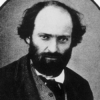Paul Cezanne

Paul Cezanne
Paul Cézannewas a French artist and Post-Impressionist painter whose work laid the foundations of the transition from the 19th-century conception of artistic endeavour to a new and radically different world of art in the 20th century. Cézanne's often repetitive, exploratory brushstrokes are highly characteristic and clearly recognizable. He used planes of colour and small brushstrokes that build up to form complex fields. The paintings convey Cézanne's intense study of his subjects...
NationalityFrench
ProfessionPainter
Date of Birth19 January 1839
CityAix-en-Provence, France
CountryFrance
An optical impression is produced on our organs of sight which makes us classify as light, half-tone or quartertone, the surfaces represented by colour sensations. So that light does not exist for the painter.
See how the light tenderly love the apricots, it takes them over completely, enters into their pulp, light them from all sides! But it is miserly with the peaches and light only one side of them.
It is necessary to introduce light vibrations, represented by reds and yellows, and a sufficient amount of blues, to obtain an airy feeling.
There is no light painting or dark painting, but simply relations of tones.
Shut your eyes, wait, think of nothing. Now, open them ... one sees nothing but a great coloured undulation. What then? An irradiation and glory of colour. This is what a picture should give us ... an abyss in which the eye is lost, a secret germination, a coloured state of grace ... loose conciousness. Descend with the painter into the dim tangled roots of things, and rise again from them in colours, be steeped in the light of them.
Shadow is a colour as light is, but less brilliant; light and shadow are only the relation of two tones.
Light is a thing that cannot be reproduced, but must be represented by something else - by color.
Right now a moment is fleeting by! Capture its reality in paint! To do that we must put all else out of our minds. We must become that moment, make ourselves a sensitive recording plate. give the image of what we actually see, forgetting everything that has been seen before our time.
I'd like to combine melancholy and sunshine... There's a sadness in Provence which no one has expressed... I'd like to put reason in the grass and tears in the sky, like Poussin...
I wished to copy nature. I could not. But I was satisfied when I discovered the sun, for instance, could not be reproduced, but only represented by something else.
To achieve progress nature alone counts, and the eye is trained through contact with her. It becomes concentric by looking and working.
I am beginning to consider myself stronger than all those around me, and you know that the good opinion I have of myself has only been reached after mature consideration.
The transposition that a painter makes with an original vision gives to the representation of nature a new interest.
To be sure an artist wishes to raise his standard intellectually as much as possible, but the man must remain in obscurity. Pleasure must be found in the studying.